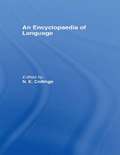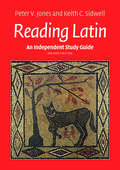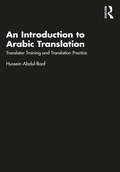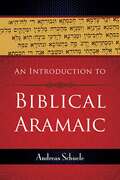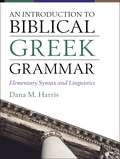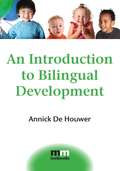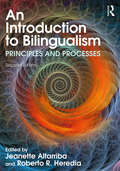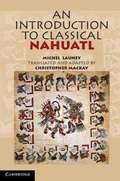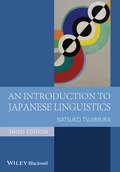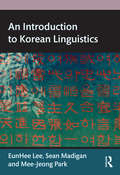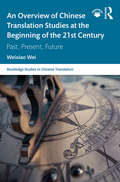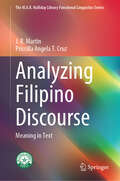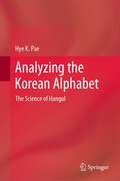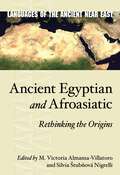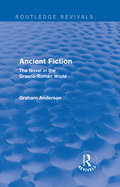- Table View
- List View
An Educator's Guide to Dual Language Instruction: Increasing Achievement and Global Competence, K–12
by Gayle Westerberg Leslie DavisonThis user-friendly book is a key resource for teachers and administrators to ensure their school’s success in implementing and maintaining a dual language program. Authors Gayle Westerberg and Leslie Davison share their own experiences leading a dual language school, the obstacles they overcame, and the best practices they learned along the way. The book is filled with step-by-step instructions and strategies you can try immediately, as well as inspirational stories from educators in urban and rural dual language programs across the country. Topics include: Choosing a model for your dual language program and involving all stakeholders in the transition process; Marketing your program effectively to recruit students and staff, including international teachers; Implementing a standards-based instructional framework focused on direct vocabulary instruction, extensive reading, and using language in context; Setting proficiency targets and using internal and external assessments to track students’ progress; Incorporating technology for a more interactive and engaging language-learning experience. You’ll also learn how to effectively transition your program through different grade levels and build a collaborative school culture for a strong, long-lasting K–12 dual language program. Additional resources are available on the authors’ website, www.duallanguageinstruction.com.
An Educator's Guide to Dual Language Instruction: Increasing Achievement and Global Competence, K–12
by Gayle Westerberg Leslie DavisonComprehensively updated, the second edition is a user- friendly resource for teachers and administrators to ensure their school’s success in implementing and maintaining a dual language program. The book is filled with step-by-step instructions and strategies you can try immediately. The second edition includes key updates on technology, digital resources, and current demographics, standards, and data. Educators will learn how to choose a model for their dual language program involving all stakeholders in the transition process, set proficiency targets and use assessments to track progress, and much more.
An Encyclopedia of Language
by N. E. Collinge* Examines how language works, accounting for its nature, its use, its study and its history* Two comprehensive indexes of Topics and Technical Terms, and Names* Carefully illustrated to explain key points in the text`This rich repository of information on all aspects of language is a must for all libraries in higher education, schools and larger public libraries.' - Library Review`Each article has an excellent bibliography. In addition, there are comprehensive indexes of topics and technical terms and names. Highly recommended for all college and general public libraries.' - Choice`This important book is in many ways a state-of-the -art survey of current conceptions of, and approaches to, language, with generous references to more detailed sources. Each chapter has a good bibliography.' - Language International`A comprehensive guide ... with very thorough bibliographies ... Collinge's Encyclopedia is recommended to academic libraries.' - Reference Reviews`The bibliographies are an invaluable aid ... the editor is to be congratulated for having done an excellent job ... there are virtually no areas of language and linguistics that do not get a look in somewhere, and there is good signposting in the text itself.' - Nigel Vincent, Times Higher Education Supplement
An Independent Study Guide to Reading Greek
by Joint Association of Classical Teachers##description##
An Independent Study Guide to Reading Latin
by Keith C. Sidwell Peter V. JonesReading Latin, first published in 1986, is a bestselling Latin course designed to help mature beginners read classical Latin fluently and intelligently. It does this by combining the understanding of continuous texts with rigorous teaching of grammar; it provides exercises designed to develop the skills of accurate translation; and it integrates the learning of classical Latin with an appreciation of the influence of the Latin language upon English and European culture from antiquity to the present. The Independent Study Guide is intended to help students who are learning Latin on their own or with only limited access to a teacher. It contains notes on the texts that appear in the Text and Vocabulary volume, translations of all the texts, and answers to the exercises in the Grammar and Exercises volume. The book will also be useful to students in schools, universities and summer schools who have to learn Latin rapidly.
An Introduction to Arabic Translation: Translator Training and Translation Practice
by Hussein Abdul-RaofCombining theory and practice, this book is a model for Arabic translation and prepares students for the translation industry. Containing 22 approaches, An Introduction to Arabic Translation provides the normative principles to guide training in Arabic-English-Arabic translation. It revitalizes Arabic-English-Arabic translation through its empirical textual reality, hinged upon Arabic and English authentic contexts and their linguistic, discoursal, and cultural incongruity. The exercises in each chapter provide practical training supported by translation theory. The translation commentaries included represent a critical translation quality assessment based on an analysis of discourse and textual features to highlight the process of translation, the translation approach adopted, and why. Such commentary invites students to reflect on their understanding of the translation process and the approach required for a given Arabic-English-Arabic translation problem. Providing a methodologically comprehensive course of Arabic-English-Arabic translation studies, and insightful discussion of high value for both students and teachers, this book will be invaluable to anyone seeking to learn or improve their Arabic and translation skills.
An Introduction to Biblical Aramaic
by Andreas SchueleThe study of biblical Aramaic, an ancient Semitic language from which the Hebrew alphabet was derived, is necessary for understanding texts written during certain periods of early Jewish and Christian history and is especially important for the study of the books of Daniel and Ezra. This new textbook is a thorough guide to learning to read and translate biblical Aramaic and includes an introduction to the language, examples of texts for practice translations, and helpful comparison charts.<P> <P> Advisory: Bookshare has learned that this book offers only partial accessibility. We have kept it in the collection because it is useful for some of our members. To explore further access options with us, please contact us through the Book Quality link on the right sidebar. Benetech is actively working on projects to improve accessibility issues such as these.
An Introduction to Biblical Greek Grammar: Elementary Syntax and Linguistics
by Dana M. HarrisAn Introduction to Biblical Greek Grammar focuses on the linguistic and syntactic elements of Koine Greek to equip learners for accurate interpretation. Drawing upon twenty years of Greek teaching experience and the latest developments in linguistics and syntax, Harris introduces students to basic linguistic concepts and categories necessary for grasping Greek in ways that are clear and intuitive. This solid foundation enables students first to internalize key concepts, then to apply and build upon them as more complex ideas are introduced.Several features are specifically designed to aid student's learning:Key concepts are graphically coded to offer visual reinforcement of explanations and to facilitate learning forms and identifying their functionsKey concepts are followed by numerous examples from the Greek New TestamentStudents learn how to mark Greek texts so that they can begin to "see" the syntax, identify the boundaries of syntactic units, and construct syntactic outlines as part of their preaching or teaching preparationFour integrative chapters, roughly corresponding to the midterms and final exams of a two-semester sequence, summarize material to date and reinforce key concepts. Here students are also introduced to exegetical and interpretive concepts and practices that they will need for subsequent Greek studies and beyond."Going Deeper" and "For the Curious" offer supplemental information for students interested in learning more or in moving to advanced language study.The accompanying workbook and video lectures (both sold separately) reinforce key concepts through additional contact with the material from each chapter of the grammar. All exercises in the workbook are taken from the Greek New Testament and the Septuagint and include extensive syntactical and exegetical notes to aid students.
An Introduction to Biblical Greek Workbook: Elementary Syntax and Linguistics
by Dana M. Harris Chi-ying WongThis workbook is designed to accompany An Introduction to Biblical Greek Grammar, which focuses on the linguistic and syntactic elements of Koine Greek to equip learners for accurate interpretation. It reinforces key concepts student learn through parsing and translation exercises for each chapter. All texts are taken from the Greek New Testament and the Septuagint and include extensive syntactical and exegetical notes to aid students.In An Introduction to Biblical Greek Grammar, author Dana Harris draws upon twenty years of Greek teaching experience and the latest developments in linguistics and syntax to introduce students to basic linguistic concepts and categories necessary for grasping Greek in ways that are clear and intuitive. This solid foundation enables students first to internalize key concepts, then to apply and build upon them as more complex ideas are introduced.Several features are specifically designed to aid student's learning:Key concepts are graphically coded to offer visual reinforcement of explanations and to facilitate learning forms and identifying their functionsKey concepts are followed by numerous examples from the Greek New TestamentStudents learn how to mark Greek texts so that they can begin to "see" the syntax, identify the boundaries of syntactic units, and construct syntactic outlines as part of their preaching or teaching preparationFour integrative chapters, roughly corresponding to the midterms and final exams of a two-semester sequence, summarize material to date and reinforce key concepts. Here students are also introduced to exegetical and interpretive concepts and practices that they will need for subsequent Greek studies and beyond."Going Deeper" and "For the Curious" offer supplemental information for students interested in learning more or in moving to advanced language study.
An Introduction to Bilingual Development
by Annick De HouwerIncreasingly, children grow up hearing two languages from birth. This introductory textbook shows how children learn to understand and speak those languages against the backdrop of their language learning environments. A narrative around the bilingual development of four young children with different language profiles helps to explain the latest research findings in a lively and accessible manner. The narrative describes how bilingually raised children learn to understand and use sounds, words and sentences in two languages, and how they are able to use each of their languages in socially appropriate ways. Positive attitudes towards bilingual development from the people in bilingual children's environments and their recognition that child bilingualism is not monolingualism-times-two are the main ingredients ensuring that children grow up to be happy and expert speakers of two languages.
An Introduction to Bilingualism: Principles and Processes
by Jeanette Altarriba Roberto R. HerediaThis important text provides a general overview of the methods and theories used in the broad domain of bilingualism. The unique interdisciplinary approach, which is reflected in the various topics covered, gives students a global picture of the field. Topics range from early childhood intellectual development to educational and social-cognitive challenges to the maturing bilingual brain. Important developing areas such as cognitive aging, creativity, the social and cultural context perspective, communication disorders and sentence processing are also covered within the volume. This text is aimed towards undergraduate courses and graduate courses in psycholinguistics, especially those with an emphasis on bilingualism or second language learning.
An Introduction to Bilingualism: Principles and Processes
by Jeanette Altarriba and Roberto R. HerediaThe study of bilingualism and all of its aspects – from theory and models to social approaches and their practical applications – forms the cornerstone of the 2nd edition of this work. The chapters cover the latest advancements in the domains of psycholinguistics, neuroscience, creativity, and executive functioning. Contributions, new to this edition, offer the reader the most up-to-date research on lifespan and developmental issues. The work also provides insight into how human language is processed by all, not just by bilingual and multilingual speakers.This text is ideal for senior undergraduate and graduate courses in psycholinguistics and the psychology of language, especially those with an emphasis on bilingualism or second language learning.
An Introduction to Classical Nahuatl
by Christopher Mackay Michel LauneyNow available to an English-speaking audience, this book is a comprehensive grammar of classical Nahuatl, the literary language of the Aztecs. It offers students of Nahuatl a complete and clear treatment of the language's structure, grammar and vocabulary. It is divided into 35 chapters, beginning with basic syntax and progressing gradually to more complex structures. Each grammatical concept is illustrated clearly with examples, exercises and passages for translation. A key is provided to allow students to check their answers. By far the most approachable textbook of Nahuatl available, this book will be an excellent teaching tool both for classroom use and for readers pursuing independent study of the language. It will be an invaluable resource to anthropologists, ethnographers, historians, archaeologists and linguists alike.
An Introduction to Foreign Language Learning and Teaching (Learning about Language)
by Keith JohnsonAn Introduction to Foreign Language Learning and Teaching provides an engaging, student-friendly guide to the field of foreign language learning and teaching. Aimed at students with no background in the area and taking a task-based approach, this book: introduces the theoretical and practical aspects of both learning and teaching; provides discussion and workshop activities throughout each chapter of the book, along with further reading and reflection tasks; deals with classroom- and task-based teaching, and covers lesson planning and testing, making the book suitable for use on practical training courses; analyses different learning styles and suggests strategies to improve language acquisition; includes examples from foreign language learning in Russian, French, and German, as well as English; is accompanied by a brand new companion website at www.routledge.com/cw/johnson, which contains additional material, exercises, and weblinks. Written by an experienced teacher and author, An Introduction to Foreign Language Learning and Teaching is essential reading for students beginning their study in the area, as well as teachers in training and those already working in the field.
An Introduction to Japanese Kanji Calligraphy
by Bob Godin Takezaki KuniiThis step-by-step Japanese calligraphy book explains the systems of Japanese language and delves into details of written Japanese characters and techniques of kanji calligraphy.The word calligraphy literally means "beautiful writing." It is an art form that can be found in most civilizations with a written script. Originally developed to stress the importance of culture, religion and philosophy, over time calligraphy in most languages has developed into a purely artistic expression.In Japanese culture, kanji characters from the Japanese writing system are used in calligraphy. An Introduction to Japanese Kanji Calligraphy is an exploration of this Asian art form, and examines how calligraphic poetry developed in Japan. Written by a Japanese shodo master, it is a wonderful introduction to the beautiful art of Japanese calligraphy.Japanese Kanji Calligraphy includes:An introduction to Japanese calligraphy Background information on the modern Japanese language Hiragana and katakana charts An explanation of the tools of calligraphy A guide to correct calligraphy techniques Step-by-step calligraphy instructions An extensive kanji character library
An Introduction to Japanese Linguistics (Blackwell Textbooks in Linguistics)
by Natsuko TsujimuraThe third edition of this established textbook has been thoroughly updated and revised. It maintains its broad coverage of topics from phonetics to language variation, and increases its accessibility by incorporating a more descriptive, less theoretical approach. A fully updated new edition of this successful textbook introducing students to a wide range of issues, phenomena, and terminology in Japanese linguistics Includes extensive revisions to the chapters on phonetics, syntax and phonology, and incorporates a less theoretical, more descriptive approach Features the author’s own data, examples and theoretical analyses throughout Offers an original approach by discussing first and/or second language acquisition within each chapter Includes exercises exploring descriptive and theoretical issues and reading lists which introduce students to the research literature, both of which have been updated in this new edition
An Introduction to Korean Linguistics
by Eunhee Lee Sean Madigan Mee-Jeong ParkAn Introduction to Korean Linguistics is a valuable and comprehensive text for those with an interest in Korean linguistics. This book provides an in-depth introduction to the basics of Korean linguistics, and modern linguistic theory, in an accessible style. It features a step-by-step approach designed to lead the reader through the linguistic make-up of the language, from the basics of its sound system and sentence structure to the semantics of modern spoken Korean. Features include: Detailed chapters covering the core areas in the field of linguistics, including phonetics, phonology, morphology and syntax Clear and accessible explanations which effectively demonstrate the intricacies and subtleties of the Korean language Suggested readings for those interested in expanding their knowledge of a specific topic Exercises designed to complement the factual and analytical issues covered in each chapter A comprehensive glossary of central terms and a companion website offering a wealth of additional materials. Korean is an invaluable language for the study of theoretical and comparative linguistics as it provides important examples and counter-examples to key issues, making An Introduction to Korean Linguistics an essential text for students and professional linguists alike.
An Introduction to Modern Japanese
by Richard Bowring Haruko Ury LaurieThis is the first book in a two-volume intensive one-year introductory course in Japanese, also suitable for those who wish to work at a slower pace. Students who finish this course will have a firm grasp of how the language works and enough knowledge of the writing system to tackle everyday written material with no more than a dictionary. Particular attention is paid to questions of grammar which foreign learners often find difficult, so Book One can also serve as a reference grammar. An Introduction to Modern Japanese uses both spoken and written forms from the outset. There are word lists for each lesson, and a comprehensive vocabulary for the whole course. Book One comprises fifty-two lessons which are accompanied by exercises and word lists in Book Two. The exercises ensure that the student has understood the grammar explained in the relevant lessons and give further practice in reading and recognising characters. Book Two also contains a full vocabulary, Japanese to English and English to Japanese.
An Introduction to Modern Japanese
by Richard Bowring Haruko Ury LaurieThis is the first book in a two-volume intensive one-year introductory course in Japanese, also suitable for those who wish to work at a slower pace. Students who finish this course will have a firm grasp of how the language works and enough knowledge of the writing system to tackle everyday written material with no more than a dictionary. Particular attention is paid to questions of grammar which foreign learners often find difficult, so Book One can also serve as a reference grammar. An Introduction to Modern Japanese uses both spoken and written forms from the outset. There are word lists for each lesson, and a comprehensive vocabulary for the whole course. Book One comprises fifty-two lessons which are accompanied by exercises and word lists in Book Two. The exercises ensure that the student has understood the grammar explained in the relevant lessons and give further practice in reading and recognising characters. Book Two also contains a full vocabulary, Japanese to English and English to Japanese.
An Irish-Speaking Island
by Nicholas M. WolfAfter 1770, Ireland experienced the establishment of modern forms of Irish Catholicism, new engagement by the public with the political process, and the growth of the modern state, represented by new legal and educational systems. An Irish-Speaking Island investigates the role in these developments of the population who spoke Irish in their daily lives#151;whether as a first or second language#151;and links the history of language contact and bilingualism with the broader history of Ireland in the eighteenth and nineteenth centuries. As late as 1840, Ireland had as many as four million Irish speakers#151;a significant proportion of the total population#151;who could be found in every county of the island and in all social classes and religious persuasions. Their impact on the modern history of Ireland and the United Kingdom cannot be captured by a simple conclusion that they became anglicized. Rather, Nicholas M. Wolf explores the complex ways in which the transition from Irish to English placed a premium on adaptive bilingualism and shaped beliefs and behavior in the domestic sphere, religious life, and oral culture within the community. An Irish-Speaking Island will interest not only historians but also scholars of linguistics, folklore, politics, literature, and religion.
An Overview of Chinese Translation Studies at the Beginning of the 21st Century: Past, Present, Future (Routledge Studies in Chinese Translation)
by Weixiao WeiAn Overview of Chinese Translation Studies at the Beginning of the 21st Century presents and analyses over 100,000 bibliographic notes contained within a large academic database focusing on translation within China. Exploring Chinese translation studies two decades before and after the year 2000, the book will introduce aspects of theory, culture, strategy, register, genre, and context to the field of translation in China, and will also take into account the impact of technology, education, and research within this field. Aimed at postgraduate students and researchers of translation studies, the focus of An Overview of Chinese Translation Studies at the Beginning of the 21st Century is the theory and practice of translation studies within a fast-paced and growing academic discipline.
Analyzing Filipino Discourse: Meaning in Text (The M.A.K. Halliday Library Functional Linguistics Series)
by J. R. Martin Priscilla Angela CruzThis book explores Filipino, the national language of the Philippines, from the perspectives of Critical Discourse Analysis (CDA) and Positive Discourse Analysis (PDA)—informed by Systemic Functional Linguistics (SFL). It is designed to encourage researchers to study Filipino texts—both spoken and written—and to unpack them in a way that clarifies their function in Philippine society. With this goal in mind, the book introduces a number of discourse analysis tools and shows how to apply them to a range of Filipino texts—including a children's picture book story, some mental health advice about coping with COVID-19, President Duterte's speech about the Philippine government's initial response to the COVID-19 pandemic, a comment piece from a student newspaper about problems with online learning modules produced by the Department of Education, and a reflective text about growing up in Davao. This is the first book to draw on a range of functional linguistic tools to analyse Filipino discourse in order to provide deeper insights into the role of language in bilingual education, the linguistic enactment of power, and the importance of thinking across languages when analysing texts. Key issues addressed include the complementarity of CDA and PDA, SFL's model of social context (as register and genre), analysing bilingual texts and bilingual education. The book fosters appliable linguistics as a dialectic of theory, description, and practice—supporting Filipino discourse analysts as they engage with the challenge of giving people access to a range of tools they can use productively to mean and thereby more successfully pursue their social goals. As such, it provides a model for researchers of other languages of how to encourage the analysis of meaning in texts within and beyond the clause. It is relevant to scholars across the spectrum of linguistics, particularly those working in Systemic Functional Linguistics.
Analyzing the Korean Alphabet: The Science of Hangul
by Hye K. PaeThis book provides comprehensive coverage of the Korean alphabet, Hangul, and includes a synthesis of research findings relating to reading in the non-Roman alphabet. This, in turn, contributes to the science of reading through an understanding of reading mechanisms that are essential for all writing systems, and that are particular for a given writing system. Hangul has been recognized as “the world’s best alphabet,” “one of the great intellectual achievements of Mankind,” and “alphabet’s epitome, a star among alphabets” by international linguists and historians. It is known that writing systems have evolved based on the ecological principle that visual signs are culturally selected to match objects found in natural scenes through selection pressures for optimal visual processing. However, Hangul is an exception. It was purposely invented by King Sejong in the 15th century to combat the illiteracy prevalent at the time. The chapters excavate the historical background of Hangul, and the unique characteristics of Hangul that contribute to learnability for emergent readers and efficiency for skilled readers. The author presents empirical evidence of psycholinguistic research into reading Hangul, building theories and presenting implications for the science of reading (psycholinguistics) and the science of writing (grapholinguistics). This book is relevant to students, researchers, and practitioners in applied linguistics, psycholinguistics, language studies, reading studies, and grammatology, with a particular focus on the Korean alphabet.
Ancient Egyptian and Afroasiatic: Rethinking the Origins (Languages of the Ancient Near East)
by M. Victoria Almansa-Villatoro and Silvia ŠtubŇovÁ NigrelliBy challenging assumptions regarding the proximity between Egyptian and Semitic Languages, Ancient Egyptian and Afroasiatic provides a fresh approach to the relationships and similarities between Ancient Egyptian, Semitic, and Afroasiatic languages. This in-depth analysis includes a re-examination of the methodologies deployed in historical linguistics and comparative grammar, a morphological study of Ancient Egyptian, and critical comparisons between Ancient Egyptian and Semitic, as well as careful considerations of environmental factors and archaeological evidence. These contributions offer a reassessment of the Afroasiatic phylum, which is based on the relations between Ancient Egyptian and the other Afroasiatic branches. This volume illustrates the advantages of viewing Ancient Egyptian in its African context.In addition to the editors, the contributors to this collection include Shiferaw Assefa, Michael Avina, Vit Bubenik, Leo Depuydt, Christopher Ehret, Zygmunt Frajzyngier, J. Lafayette Gaston, Tiffany Gleason, John Huehnergard, Andrew Kitchen, Elsa Oréal, Chelsea Sanker, Lameen Souag, Andréas Stauder, Deven N. Vyas, Aren Wilson-Wright, and Jean Winand.
Ancient Fiction: The Novel in the Graeco-Roman World (Routledge Revivals)
by Graham AndersonA number of ancient novelists were skilful storytellers and resourceful literary artists, and their works are often carefully individualised presentations of an ancient and distinguished heritage. Ancient Fiction, first published in 1984, examines the tales retold by these novelists in light of more recently discovered Near Eastern texts, and in this way offers a tentative solution to Rohde’s celebrated problem about the origins of the Greek novel. Among the surprises that emerge are an ancient stratum of the Arabian Nights and a possible Tristan-Romance, as well as an animal Satyricon and a human Golden Ass. This new framework is, however, incidental to an examination of the achievements of ancient novelists in their own right. In presenting character, structuring narrative, imposing a veneer of sophistication or contriving a religious ethos, these writers demonstrate that their work is worthy of sympathetic study, rather dismissal as the pulp fiction of the ancient world.


